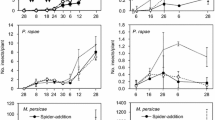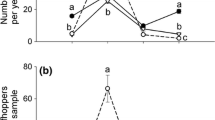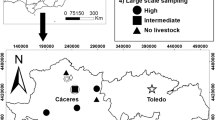Abstract
Outbreaks of the blue willow beetle Phratora vulgatissima (L.) (Coleoptera: Chrysomelidae) threaten the yield of willow plantations that rely on biological control by natural enemies. Here we show that weed presence increases herbivore and predator/parasitoid diversity on willow shoots and causes increased predation on P. vulgatissima eggs compared to shoots within plots without weeds. We argue that, in addition to higher abundance, the community shift in favour of egg consumers and additive predator effects causes the higher predation pressure. This increase (~35 %) was apparent despite more alternative prey. Neither the willow genotype on which the predator–prey interaction occurred nor the clutch size affected egg predation levels. Our results support root’s enemy hypothesis and suggest that intensive weed control might counteract biological control in willow plantations. However, at least during the establishing phase of the plantation, increased biocontrol probably does not compensate for yield losses caused by competing weeds.




Similar content being viewed by others
References
Åhman I (2001) Management of pests and diseases in biomass willow. Sver Utsädesfören Tidskr 111:98–103
Albertsson J, Hansson D, Bertholdsson NO, Åhman I (2014a) Site-related set-back by weeds on the establishment of 12 biomass willow clones. Weed Res 54:398–407
Albertsson J, Verwijst T, Hansson D, Bertholdsson NO, Åhman I (2014b) Effects of competition between short-rotation willow and weeds on performance of different clones and associated weed flora during the first harvest cycle. Biomass Bioenergy 70:364–372
Altieri MA (1999) The ecological role of biodiversity in agroecosystems. Agric Ecosyst Environ 74:19–31
Andow D (1991) Vegetational diversity and arthropod population response. Annu Rev Entomol 36:561–586
Baffoe K, Dalin P, Nordlander G, Stenberg JA (2012) Importance of temperature for the performance and biocontrol efficiency of the parasitoid Perilitus brevicollis (Hymenoptera: braconidae) on Salix. BioControl 57:611–618
Bates DM, Maechler M, Bolker BM, Walker S (2014) lme4: linear mixed-effects models using Eigen and S4. R Package Version 1.1–7. http://CRAN.R-project.org/package=lme4
Bennett AB, Gratton C (2013) Floral diversity increases beneficial arthropod richness and decreases variability in arthropod community composition. Ecol Appl 23:86–95
Björkman C, Bommarco R (2004) Harvesting disrupts biological control of herbivores in a short-rotation coppice system. Ecol Appl 14:1624–1633
Björkman C, Liman A-S (2005) Foraging behaviour influences the outcome of predator-predator interactions. Ecol Entomol 30:164–169
Björkman C, Höglund S, Eklund K, Larsson S (2000) Effects of leaf beetle damage on stem wood production in coppicing willow. Agric For Entomol 2:131–139
Björkman C, Dalin P, Eklund K (2003) Generalist natural enemies of a willow leaf beetle (Phratora vulgatissima): abundance and feeding habits. J Insect Behav 16:747–764
Björkman C, Johansson H, Snäll T (2011) Spatial distribution of interacting insect predators: possible roles of intraguild predation and the surrounding habitat. Basic Appl Ecol 12:516–522
Burda M (2013) paircompviz: multiple comparison test visualization. R package version 1.3.0
Caslin B, Finnan J, McCracken A (2010) Short rotation coppice willow best practice guidelines. Agri-Food and Bioscience Institute, Belfast
Clay DV, Dixon FL (1995) Vegetation management in the establishment of poplar and willow short-rotation coppice. Brighton crop protection conference: weeds. Proceedings of an international conference, Brighton, pp 979–984
Dalin P, Kindvall O, Björkman C (2006) Predator foraging strategy influences prey population dynamics: arthropods predating a gregarious leaf beetle. Anim Behav 72:1025–1034
Dalin P, Kindvall O, Björkman C (2009) Reduced population control of an insect pest in managed willow monocultures. PLoS ONE 4:e5487
Dempster J (1960) A quantitative study of the predators on the eggs and larvae of the broom beetle, Phytodecta olivacea forster, using the precipitin test. J Anim Ecol 29:149–167
Elton CS (2000) The ecology of invasions by animals and plants. University of Chicago Press, Chicago
Fox J, Weisberg S (2011) An {R} companion to applied regression. Sage Publications, Thousand Oaks
Godfray HCJ, Partridge L, Harvey PH (1991) Clutch Size. Annu Rev Ecol Syst 22:409–429
Gurr G, Wratten S, Luna J (2003) Multi-function agricultural biodiversity: pest management and other benefits. Basic Appl Ecol 116:107–116
Haenke S, Scheid B, Schaefer M, Tscharntke T, Thies C (2009) Increasing syrphid fly diversity and density in sown flower strips within simple vs. complex landscapes. J Appl Ecol 46:1106–1114
Hooks C, Johnson M (2006) Population densities of herbivorous lepidopterans in diverse cruciferous cropping habitats: effects of mixed cropping and using a living mulch. BioControl 51:485–506
Hothorn T, Bretz F, Westfall P (2008) Simultaneous inference in general parametric models. Biometrical J 50:346–363
Karp A, Shield I (2008) Bioenergy from plants and the sustainable yield challenge. New Phytol 179:15–32
Kendall D, Wiltshire C, Butcher M (1996) Phenology and population dynamics of willow beetles (Coleoptera; Chrysomelidae) in short-rotation coppiced willows at Long Ashton. ETSU (DTI) Biofuels Study B/M4/00487/14/REP. IACR-Long Ashton Research Station, Bristol
Keoleian GA, Volk TA (2005) Renewable energy from willow biomass crops: life cycle energy, environmental and economic performance. CRC Crit Rev Plant Sci 24:385–406
Landis DA, Wratten SD, Gurr GM (2000) Habitat management to conserve natural enemies of arthropod pests in agriculture. Annu Rev Entomol 45:175–201
Lehrman A, Torp M, Stenberg JA, Julkunen-Tiitto R, Björkman C (2012) Estimating direct resistance in willows against a major insect pest, Phratora vulgatissima, by comparing life history traits. Entomol Exp Appl 144:93–100
Lundgren JG, Wyckhuys KAG, Desneux N (2008) Population responses by Orius insidiosus to vegetational diversity. BioControl 54:135–142
Nilsson U, Rännbäck LM, Anderson P, Rämert B (2012) Herbivore response to habitat manipulation with floral resources: a study of the cabbage root fly. J Appl Entomol 136:481–489
O’Neal ME, Zontek EL, Szendrei Z, Landis DA, Isaacs R (2005) Ground predator abundance affects prey removal in highbush blueberry (Vaccinium corymbosum) fields and can be altered by aisle ground covers. BioControl 50:205–222
Oksanen J, Blanchet FG, Kindt R, Legendre P, O’Hara RB, Simpson GL, Solymos P, Stevens M, Henry H, Wagner H (2012) vegan: community ecology package. https://cran.r-project.org/web/packages/vegan/
Pimentel D (1961) Species diversity and insect population outbreaks. Ann Entomol Soc Am 5:76–86
Root R (1973) Organization of a plant-arthropod association in simple and diverse habitats: the fauna of collards (Brassica oleracea). Ecol Monogr 43:95–124
Root R, Cappuccino N (1992) Patterns in population change and the organization of the insect community associated with goldenrod. Ecol Monogr 62:393–420
Stenberg J (2012) Plant-mediated effects of different Salix species on the performance of the braconid parasitoid Perilitus brevicollis. Biol Control 60:54–58
Stenberg JA, Lehrman A, Björkman C (2010) Uncoupling direct and indirect plant defences: novel opportunities for improving crop security in willow plantations. Agric Ecosyst Environ 139:528–533
Stenberg JA, Lehrman A, Björkman C (2011a) Host-plant genotype mediates supply and demand of animal food in an omnivorous insect. Ecol Entomol 36:442–449
Stenberg JA, Lehrman A, Björkman C (2011b) Plant defence: feeding your bodyguards can be counter-productive. Basic Appl Ecol 12:629–633
Stephan JG, Stenberg JA, Björkman C (2015) How far away is the next basket of eggs? Spatial memory and perceived cues shape aggregation patterns in a leaf beetle. Ecology 96:908–914
Straub CS, Finke DL, Snyder WE (2008) Are the conservation of natural enemy biodiversity and biological control compatible goals? Biol Control 45:225–237
R Core Team (2014) R: a language and environment for statistical computing. R Foundation for Statistical Computing, Vienna. URL http://www.R-project.org
Urbanek S, Horner J (2012) Cairo: R graphics device using Cairo graphics library for creating high-quality bitmap (PNG, JPEG, TIFF), vector (PDF, SVG, PostScript) and display (X11 and Win32) output. R package version 1.5–6. http://CRAN.R-project.org/package=Cairo
Vandermeer J (2011) The ecology of agroecosystems. Jones & Bartlett Learning, Burlington
Walter GH (2003) Insect pest management and ecological research. Cambridge University Press, Cambridge
Wheeler AGJ (2001) Biology of the plant bugs (Hemiptera: Miridae), pests, predators. Cornell University Press, Ithaca
Winkler K, Wäckers FL, Termorshuizen AJ, van Lenteren JC (2010) Assessing risks and benefits of floral supplements in conservation biological control. BioControl 55:719–727
Zuur A, Ieno E, Elphick C (2010) A protocol for data exploration to avoid common statistical problems. Methods Ecol Evol 1:3–14
Acknowledgments
We thank Sten Segerslätt and Stig Larsson from European Willow Breeding AB for providing the northwest site. JS is most grateful for funding from the Helge Ax:son Johnsons Foundation that made this study possible. Matthieu Laurent and Carol V. Amaya-Gómez provided technical assistance. This study was further funded by the Swedish Energy Agency (Energimyndigheten) and the Swedish Research Agency Formas.
Author information
Authors and Affiliations
Corresponding author
Additional information
Handling Editor: S. Raghu.
Electronic supplementary material
Below is the link to the electronic supplementary material.
Rights and permissions
About this article
Cite this article
Stephan, J.G., Albertsson, J., Wang, L. et al. Weeds within willow short-rotation coppices alter the arthropod community and improve biological control of the blue willow beetle. BioControl 61, 103–114 (2016). https://doi.org/10.1007/s10526-015-9693-0
Received:
Accepted:
Published:
Issue Date:
DOI: https://doi.org/10.1007/s10526-015-9693-0




